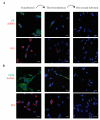Development of a Multivalent Kunjin Virus Reporter Virus-Like Particle System Inducing Seroconversion for Ebola and West Nile Virus Proteins in Mice
- PMID: 33260425
- PMCID: PMC7760487
- DOI: 10.3390/microorganisms8121890
Development of a Multivalent Kunjin Virus Reporter Virus-Like Particle System Inducing Seroconversion for Ebola and West Nile Virus Proteins in Mice
Abstract
Kunjin virus (KUNV) is an attenuated strain of the severe neurotropic West Nile virus (WNV). The virus has a single-strand positive-sense RNA genome that encodes a polyprotein. Following gene expression, the polyprotein is cleaved into structural proteins for viral packaging and nonstructural proteins for viral replication and expression. Removal of the structural genes generate subgenomic replicons that maintain replication capacity. Co-expression of these replicons with the viral structural genes produces reporter virus-like particles (RVPs) which infect cells in a single round. In this study, we aimed to develop a system to generate multivalent RVPs based on KUNV to elicit an immune response against different viruses. We selected the Ebola virus (EBOV) glycoprotein (GP) and the matrix protein (VP40) genes, as candidates to be delivered by KUNV RVPs. Initially, we enhanced the production of KUNV RVPs by generating a stable cell line expressing the KUNV packaging system comprising capsid, precursor membrane, and envelope. Transfection of the DNA-based KUNV replicon into this cell line resulted in an enhanced RVP production. The replicon was expressed in the stable cell line to produce the RVPs that allowed the delivery of EBOV GP and VP40 genes into other cells. Finally, we immunized BALB/cN mice with RVPs, resulting in seroconversion for EBOV GP, EBOV VP40, WNV nonstructural protein 1, and WNV E protein. Thus, our study shows that KUNV RVPs may function as a WNV vaccine candidate and RVPs can be used as a gene delivery system in the development of future EBOV vaccines.
Keywords: Ebola virus; Kunjin virus; glycoprotein (GP); matrix protein (VP40); packaging system; replicons; reporter virus-like particles (RVPs); seroconversion; stable cell line; vaccines.
Conflict of interest statement
The authors declare no conflict of interest.
Figures







Similar articles
-
Enhanced Seroconversion to West Nile Virus Proteins in Mice by West Nile Kunjin Replicon Virus-like Particles Expressing Glycoproteins from Crimean-Congo Hemorrhagic Fever Virus.Pathogens. 2022 Feb 10;11(2):233. doi: 10.3390/pathogens11020233. Pathogens. 2022. PMID: 35215177 Free PMC article.
-
Distinct Immunogenicity and Efficacy of Poxvirus-Based Vaccine Candidates against Ebola Virus Expressing GP and VP40 Proteins.J Virol. 2018 May 14;92(11):e00363-18. doi: 10.1128/JVI.00363-18. Print 2018 Jun 1. J Virol. 2018. PMID: 29514907 Free PMC article.
-
Recombinant Modified Vaccinia Virus Ankara Generating Ebola Virus-Like Particles.J Virol. 2017 May 12;91(11):e00343-17. doi: 10.1128/JVI.00343-17. Print 2017 Jun 1. J Virol. 2017. PMID: 28331098 Free PMC article.
-
Kunjin RNA replication and applications of Kunjin replicons.Adv Virus Res. 2003;59:99-140. doi: 10.1016/s0065-3527(03)59004-2. Adv Virus Res. 2003. PMID: 14696328 Review.
-
West nile virus (Kunjin subtype) disease in the northern territory of Australia--a case of encephalitis and review of all reported cases.Am J Trop Med Hyg. 2011 Nov;85(5):952-6. doi: 10.4269/ajtmh.2011.11-0165. Am J Trop Med Hyg. 2011. PMID: 22049056 Free PMC article. Review.
Cited by
-
Roles of the Endogenous Lunapark Protein during Flavivirus Replication.Viruses. 2021 Jun 22;13(7):1198. doi: 10.3390/v13071198. Viruses. 2021. PMID: 34206552 Free PMC article.
-
Is There a Future for Traditional Immunogens When We Have mRNA?Microorganisms. 2023 Apr 12;11(4):1004. doi: 10.3390/microorganisms11041004. Microorganisms. 2023. PMID: 37110427 Free PMC article.
-
Enhanced Seroconversion to West Nile Virus Proteins in Mice by West Nile Kunjin Replicon Virus-like Particles Expressing Glycoproteins from Crimean-Congo Hemorrhagic Fever Virus.Pathogens. 2022 Feb 10;11(2):233. doi: 10.3390/pathogens11020233. Pathogens. 2022. PMID: 35215177 Free PMC article.
-
Unique Mode of Antiviral Action of a Marine Alkaloid against Ebola Virus and SARS-CoV-2.Viruses. 2022 Apr 15;14(4):816. doi: 10.3390/v14040816. Viruses. 2022. PMID: 35458549 Free PMC article.
References
-
- American CDC. [(accessed on 30 August 2020)]; Available online: https://www.cdc.gov/westnile/statsmaps/cumMapsData.html.
-
- Hall R.A., Broom A.K., Smith D.W., Mackenzie J.S. The Ecology and Epidemiology of Kunjin Virus. In: Mackenzie J.S., Barrett A.D.T., Deubel V., editors. Japanese Encephalitis and West Nile Viruses. Springer; Berlin/Heidelberg, Germany: 2002. pp. 253–269. - PubMed
-
- Laurent-Rolle M., Boer E.F., Lubick K.J., Wolfinbarger J.B., Carmody A.B., Rockx B., Liu W., Ashour J., Shupert W.L., Holbrook M.R., et al. The NS5 Protein of the Virulent West Nile Virus NY99 Strain Is a Potent Antagonist of Type I Interferon-Mediated JAK-STAT Signaling. J. Virol. 2010;84:3503. doi: 10.1128/JVI.01161-09. - DOI - PMC - PubMed
Grants and funding
LinkOut - more resources
Full Text Sources
Research Materials

